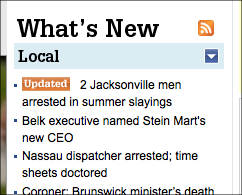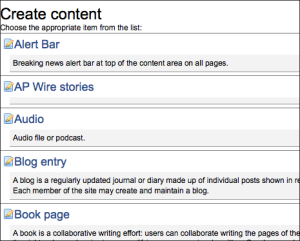In a comment yesterday, Ed Kohler raised some questions about timely vs. "stale news" that I thought I'd address by turning back to my theme of basic assumptions and assertions behind our site management system. Timeliness is right at the top of the list.

I've known all along that the online journalism has to be conducted in a world of "continuous now." The "continuous news desk" function was an assumption back in 1994 when we were building the first online services at the Star Tribune in Minneapolis.
Yet I still see a lot of systems built around antiquated concepts like "editions."
We're not going down that road at all. Continuous updating and instant publication have been a primary goal of this project since we started.
But there are barriers. Our newspaper newsrooms still rely on antiquated, print-centric systems for internal workflow as written copy passes through various stages of editing.
When it's ready for publication, a story can be immediately released to the Web -- but you have to be a bit patient, because it then passes through a bucket brigade of software and systems. Eventually it'll show up on the Web, but you'd better not hold your breath.
This sort of thing drives a lot of newsrooms to "fix" the problem by using blog software.
But that creates a silo of timely content that's never integrated back into the topical collections on the main site. At some newspapers, there's not even branding and ad positions on fresh news items.
In the course of this project, we've shortened and tightened and accelerated that path from the antique world to the Internet, but it's still a problem.
So here's a solution: you don't have to do it that way.

Since Drupal began its life as bloglike software, "post it right now" is a built-in feature. All you need is an account and the right permissions.
In our model, some content will still flow from the legacy system, but every reporter is expected to know how to post directly on the Web. This means stories can be filed immediately from anywhere, so long as you have a laptop (or a netbook) and an Internet connection.
Using Drupal's contributed family of Content Construction Kit modules, we've created more than 30 specialty content types for specific purposes. The basic "editorial node" is just one of those types, but it's a central and important one. (I'll talk about some of the others in a future post.)
Creating creating a story isn't much harder than simple blogging. Yet the "editorial node" type is a rich one, and when we run internal training sessions we can easily spend half an hour talking about its many possibilities.
We accommodate multiple photos, which are automatically displayed in a dynamic widget. Videos (we use Brightcove) are properly sized and embedded. If you indicate that the story is about a company with a stock symbol, the system embeds a little block linking to live ticker info. Are there related stories? Start typing the headline of one, and an Ajax-enhanced tool will dynamically look it up and create a bidirectional link. And so on.
But you don't have to do those things. Breaking news can be posted immediately in its simplest form, then updated, freshened, expanded and enhanced throughout the day. Since the system is database-driven and dynamic, updated items can be flagged (as you can see here in the top image).
Ultimately, technology isn't enough. Breaking news requires human beings to discover and tell the story. The best we can do with tools is make sure we've removed the barriers.

Comments
30 Content Types?
Deployment and change management
Yeah
Live site
Jacksonville site is very impressive
Drupal documentation
Some of the Drupal documentation is great, and other parts work only for specific audiences. Theme development is a special interest of mine, and while the Drupal 6 theme guide is arguably much better, it's completely inappropriate for a designer who wants to develop a theme (while being great for hardcore PHP developers). I'm currently reading Packt's new book "Drupal 6 Themes" and will post a review when I get that far.
Panels and Views are such a moving target that the only real way to learn them is to do a local install and play with them for hours. We're still discovering things even after launch.
Can't give you any advice on hosting unless you have $100 to spend monthly, in which case I've found Server Beach to be great (dedicated hardware, not VPS).